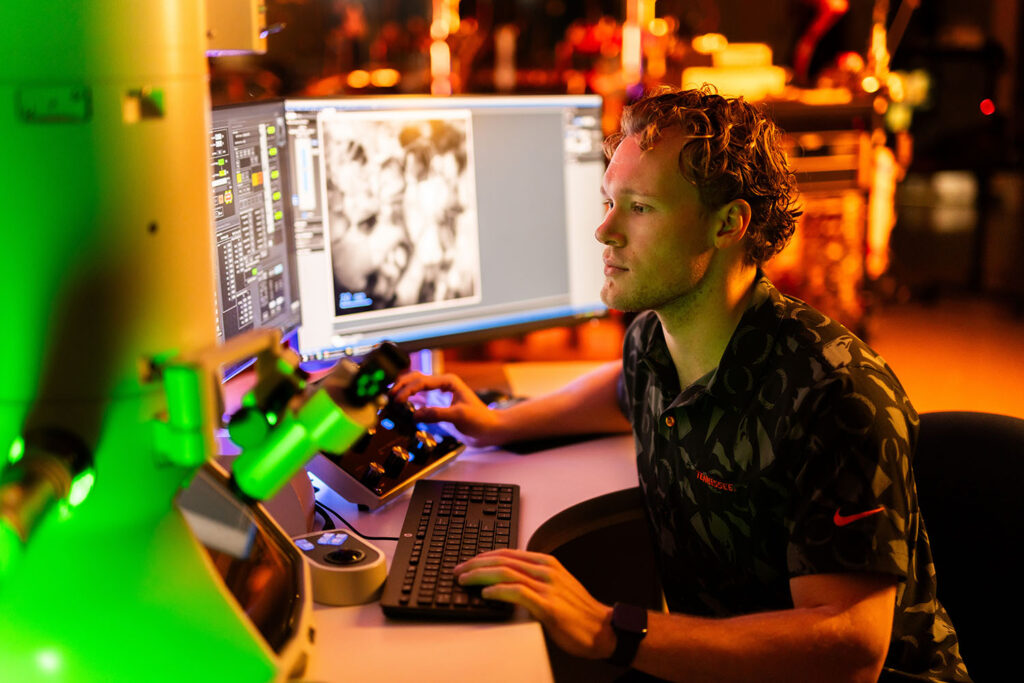Andrew Wood had several options to consider for graduate school. He was accepted to all of the major civil engineering programs where he applied. One main thing gave the University of Tennessee’s Tickle College of Engineering the edge.
“The type of research that I was going to do at UT was state of the art, and I wanted to learn something new,” said Wood, a Colorado native. “It was an opportunity that I wouldn’t be able to have anywhere else in the country.”
Wood is studying under Fred N. Peebles Professor and IAMM Chair of Excellence Dayakar Penumadu at the Materials Research Science and Engineering Center (MRSEC) as part of IRG2, which focuses on advancing next-generation alloys and ceramics for extremes.
Wood’s group is characterizing materials from a newer additively manufacturing system. The manufacturing method shows promise for producing high quality structural materials for aerospace and nuclear applications that are stable at high temperatures.
“My group determines mechanical properties on a range of scales, from nano to bulk scale,” Wood said. “The properties display the microstructural information of the material which has a huge role in predicting how the material will behave for its application.”
The MRSEC includes students from all engineering disciplines within TCE along with math and physics majors. The collaborative environment has expanded Wood’s knowledge base and enhanced his skillset.
“This is a unique program since a variety of disciplines come together to collaborate to create and characterize these materials, which is very unique from most graduate programs,” said Wood, who received his undergraduate degree at New Mexico State University and worked for a year as a substation structural engineer. “Before this, I had no experience in materials science or anything like that. So, it’s been a challenging learning curve, however I’ve had lots of guidance and mentoring along the way to help achieve my research goals.”
MRSEC’s Civil Connections
Wood is one of two civil engineering majors in his MRSEC group, along with Munireach Nannory. Wood handles the mechanical testing and Nannory does the finite elemental modeling version of the testing.
“We work together to develop a model that can solve new and complex problems and should align with the physical testing,” Wood said. “Due to the cost and time of the manufacturing of the materials involved, the goal is to have models that will give us results of these new materials without having to physically test them, providing an efficient and effective way for characterization.”
Applying his background in civil engineering to the MRSEC research work his team is doing has been extremely rewarding and insightful for Wood as he pursues his PhD.

“What I didn’t realize going into the materials field is that most of the basic principles that you learn in civil engineering, especially in the structural field like modulus and strength, can be applied on a much finer scale to characterize various materials,” Wood said.
“It’s like designing civil structures but on a finite scale, where the smallest change for applications such as a layer of a nuclear reactor component or parts of a hyper-sonic aircraft can cause an entire system to fail due to defects or phase transformations. You have to take into account all of the extreme environments the materials will encounter and try and replicate that in your lab on a nano scale and predict how the microstructure will react.”
Wood’s interest in engineering began during childhood. He’s always been fascinated by building things and problem solving. He’s excited to gain more research experience over the next three years at UT that can be used in his future career.
“I want to go into private industry like Lockheed Martin or SpaceX,” Wood said. “I also wouldn’t mind pursuing a career at the national labs, such as Oak Ridge or Los Alamos.”
Contact
Rhiannon Potkey (865-974-0683, rpotkey@utk.edu)
